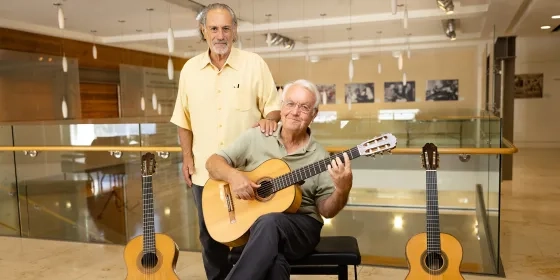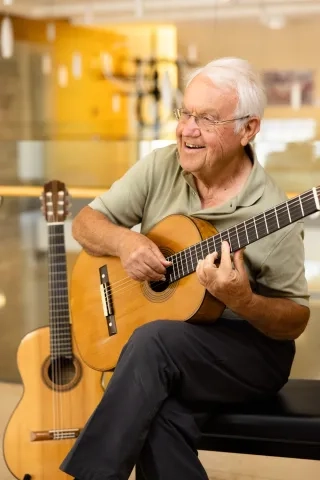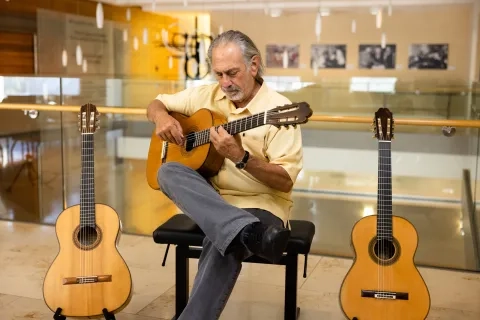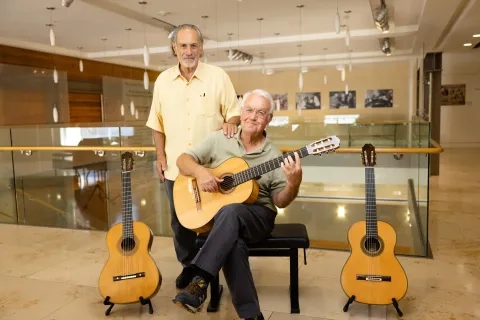The Story of SFCM’s Guitar Department and Its Historic Harris Collection
Why SFCM's guitar collection stands alone.
By Alex Heigl
Andrés Segovia said guitars only last 25 years,” George Sakellariou, the founder of SFCM’s guitar department and a student of the Spanish guitar master, said. “But he was wrong.”
While that might sound like blasphemy, it’s good news for SFCM students, who have access to a wide range of stunning instruments—some of them considerably older than 25 years—as part of the Harris Guitar Collection, donated in 2019 by writer, artist, and guitarist L. John Harris. The 40-strong collection’s arrival at the Conservatory was somewhat overshadowed by the COVID-19 pandemic, but with the return of in-person classes and performances, students and the public can again hear and play these marvelous instruments. Harris and Sakellariou are also prepping an album for release that features Sakellariou playing three of the collection’s crown jewels, including an instrument from 1888, made by the legendary Andalusian guitar maker, Antonio de Torres.
But the story of the Harris Collection and SFCM’s guitar department starts years earlier, across the Bay, in Berkeley.
“In 1964, I had recently arrived here from Greece, and it just so happened that Segovia was giving a masterclass at UC Berkeley, and I showed up at the first session,” Sakellariou said. “I paid $5 to audit the class, and then during the intermission, Segovia was going for lunch, and there was a split-second when I approached him and told him who I was, and he had heard of my teacher, Charalambos Ekmetsoglou, at the conservatory in Athens.”
Sakellariou was able to borrow a guitar from another student at the masterclass and showed up to Segovia’s hotel room at the appointed time. Two of the three students before him were in and out of the room quickly, while Segovia said something “not nice” to the third, before Sakellariou went in to play for him—and began by playing the same piece the previous student had played. But Segovia asked him to keep playing for him, and ultimately accepted the 20-year-old Sakellariou as his student. “I wasn’t nervous,” he said. “My only goal was to be with him close-up. He was my idol since I was 5 years old. So to be next to him, I was happy.”
At the time, SFCM’s guitar department was taught by a man named Robin Brown, who approached Sakellariou about teaching at the Conservatory. Sakellariou ended up with a studio of about 35 students under his wing by 1966, just two years after arriving at the Conservatory. Sakellariou taught at SFCM until 1987, when current guitar department Chair David Tanenbaum took over.
“I would not be exaggerating to call the Torres the best guitar I have ever played, and I have played many guitars,” Sakellariou said of the instrument in the Collection that appears on the forthcoming album. But it’s not the only instrument he loves from the Collection: He performs one Bach’s preludes on the album on a guitar from 1987, made by José Romanillos, which he said had a tonal range he felt suited the piece. (Romanillos has authored the definitive book on Torres and is the key reference for these guitars.) The third guitar on the album, a 1961 model made by a Parisian guitar maker named Robert Bouchet—who came to his profession only after working as a painter—is a favorite of George’s for the control over the entire dynamic range it affords him.
Restoring guitars as old as the Torres is an extremely tricky process, owing to the complex relationship between the wood itself and the varnish that the guitar has been finished with, Harris explained. Luthiers will attempt to remove as little of the original varnish as possible, because in some cases, it can actually have crystallized into the wood itself, which adds to the guitar’s resonance and sustain. Some luthiers have historically-accurate “recipes” for the varnish they use in repairs to attempt to repair guitars with as close to period-accurate materials as possible.
As a guitar maker, Torres’ influence is enormous: “Between Torres and the present, the guitar has stayed pretty much as he created it,” Harris said. But the Harris collection also includes guitars from that pre-date his designs and showcase a history of the guitar before the Spanish-style model became the dominant one: French models from 1815 and 1830 and a London-made instrument from 1837.
“Part of my goal is to have these guitars considered both collectible icons and playable tools,” Harris said of the collection. “I don’t want to lose the idea of these being instruments: Some collectors will buy historically significant guitars regardless of their sound, and that wasn’t my intention.” The recording project with Sakellariou is one way to keep the instruments in circulation, as it were, but Harris stresses that they’re a way for students to literally connect them to the history of their instrument. (His long-term project is getting every instrument in the collection recorded by SFCM students and faculty.)
“I’m not aware of any other conservatory with a collection [like this],” Harris said. “I know that pretty much for a fact.”
“For a student, to develop a taste for what is a beautiful sound on the guitar, you have to try many guitars,” Sakellariou said. “The first guitar I played was my teacher’s in Greece; it was the last guitar made by [Hermann] Hauser, Sr. It was a beautiful guitar, and I remember playing it and it sent shivers through me, a moment I will never forget. Playing many different instruments lets students say, ‘Yes, this is what I like, and that stays with them.”
Harris continued, “When you get a student who’s never played these guitars, the first time they hear a Torres or a Hauser, they go nuts. Several months ago we met with a group of students, and I left the session so excited myself—about their excitement! They were almost screaming. To be able to make that happen for students … it’s not just, ‘Oh, this is an interesting old guitar.’ We want students to have experiences with these instruments that they’ll remember.”
Learn more about studying guitar at SFCM or the Harris Guitar Collection here, and read George Sakellariou’s interview for the SFCM library’s oral history project here.



